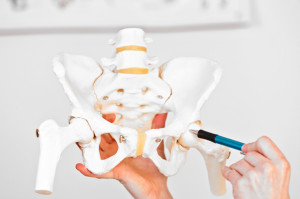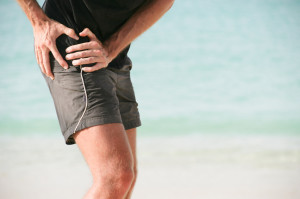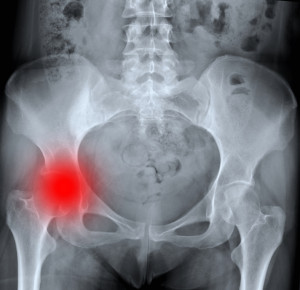Hip Injury: Introduction
Although not injured as often as the knee, leg, ankle or foot, the hip area is still commonly injured in athletes and non-athletes alike. Our hips and legs support our entire body, giving us strength, stability, flexibility and mobility. So, it’s no wonder the aging process can also lead to hip pain and injury. Orthopedic hip specialists at AOSMI are here to help determine the cause of your pain and treat your injuries
The hip is a ball and socket joint responsible for allowing movement of the legs. Luckily, it’s rather robust, so the typical hip joint is not likely to get injured. Structures around your hip, including the hip bursa and labrum, are typically the source of pain. Sometimes, however, your hip pain is actually caused by pain in the lower back, such as the sciatica. Hip pain can sometimes travel down the leg to the knee as well. A common source of hip pain is also the tendons, and most often, the iliopsoas tendon. The muscles of your hip also can become painful, including the gluteus musculature, which makes up the buttock.
Hip Pain Causes
With so many components making up this body part, there are a wide variety of causes for hip pain.

- Degeneration – Occurs with aging and injuries to the hips such as falls, while playing sports or motor vehicle accidents
- Injury – Elderly patients often develop thin bones, which make their hips more prone to fractures
- Overuse –Less common, but often caused by placing your hip repetitively in an extreme position, such as in gymnastic activities or pitching
Diseases
NJ orthopedic specialists at AOSMI find that the most common diseases of the hip include:
- Hip Arthritis – Degeneration or thinning of the cartilage and structures around your hip joint. The cartilage can become worn away over time to the point where the bones start rubbing causing extreme pain and difficulty walking.
- Labral Tear – When the surrounding cartilage of your hip joint becomes torn, you may experience a popping and significant pain in certain positions. Labral tears can be caused by an injury such as a trauma or sometimes from degeneration.
- Femoroacetabular Impingement (FAI) and Hip Dysplasia (DDH): Common in younger patients, these are abnormalities of the bone or shape of the bones of your hip that cause them to contact each other in an abnormal fashion. This generates significant stress and early breakdown of the structures around the hip.
- Hip Fractures – Common in the elderly and usually caused by osteoporosis, thinning and weakening of the bone, combined with a fall from a standing height such as trip and fall. In rare cases, this can happen in younger patients, but it usually requires more force such as a motor vehicle accident or a more forceful injury. A rare disease known as “stress fractures” can affect your hip when the fracture builds up slowly over time until the bone breaks.
- Hip Bursitis: An extremely common cause of hip pain typically felt on the outside of the hip and sometimes radiating down the side of the leg. Caused by inflammation and rubbing of the hip on the surrounding structures.
- Radiating Lumbar Pain – Radiating pain from the back is a very common cause of hip pain, usually caused by the pinching of nerves in the lower back from herniated discs or foraminal stenosis. This is sometimes called “sciatica”.
- Avascular Necrosis – Most commonly occurring in the hip or knee, this disease is caused by loss of blood supply resulting in loss of structural integrity as bone cells die. The joint becomes stiff and the cartilage wears, causing pain and difficulties walking.
Evaluation
At AOSMI, your hip pain will be evaluated with a detailed history reporting and physical examination. Often, your hip is placed into certain positions to find the source of the pain. The motion of your hip joint is often measured and compared to normal values.
X-rays of your hip and pelvis are often necessary to evaluate for fractures and abnormalities of your bone such as in femoroacetabular impingement syndrome. Often, MRI with contrast, called “MRI arthrogram” is used to look deeper into the hip. This can be used to diagnose labral tears, dysplasia or bony abnormalities and bursitis. Bone scan is uncommonly used for hip pain, but it can be helpful in diagnosing stress fractures and tumors. A CT-scan can be used to find fractures and further analyze the bones of your hip.
Hip Pain Treatments
Once a thorough evaluation is done and a diagnosis is confirmed, your physician will develop a treatment plan that may include conservative and/or surgical therapies.
Conservative

An orthopedic hip specialist can often treat your hip pain conservatively with:
- Medications such non-steroidal anti-inflammatory drugs (NSAIDs)
- Massage, acupuncture and physical therapy
- Injections, such as steroid injections are helpful in hip joint arthritis, as well as hip bursitis. Viscosupplementation (hyaluronic acid) injections are newer treatments that can be considered for the hip
Surgical
There are a variety of surgical procedures to treat hip problems:
- Minimally Invasive Hip Replacement Surgery – One of the most successful surgical procedures performed by hip replacement surgeons involving total replacement of the degenerative portions of your hip joint with a prosthetic ball and socket implant allowing for excellent restoration of function, return to activities and complete relief of pain.
- Direct Anterior Total Hip Replacement Surgery
- Hip Arthroscopy – Useful in dealing with problems like labral tears and hip impingement, and performed with tiny incisions on the side of your hip. This allows the orthopedic hip specialist to look deep within your hip joint using fiber optic technology to treat a variety of disorders.
- Open Reduction/Internal Fixation – Treats fractures utilizing plates and screws to put the fragments of the bone back together
- Intramedullary Fixation – A less invasive technique that fixes hip fractures by stabilizing your bone from the inside with a rod-type implant.
- Hemiarthroplasty (partial joint replacement) – Sometimes the hip fracture cannot be put back together reliably and therefore, the hip joint can be either partially or completely replaced with a prosthetic implant
Although hip pain is not as common as some other types of problems, it can occur at any point in our lives. If you’ve had an athletic injury or are experiencing the pain of aging, contact NJ orthopedic specialists AOSMI today at 732.720.2555.







